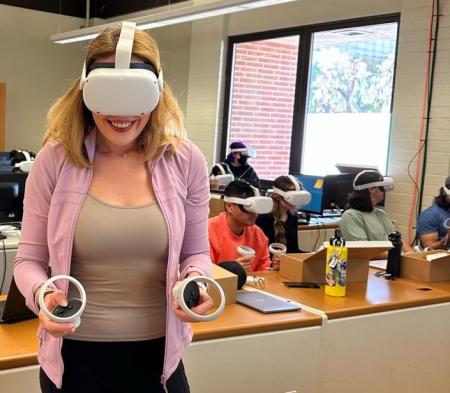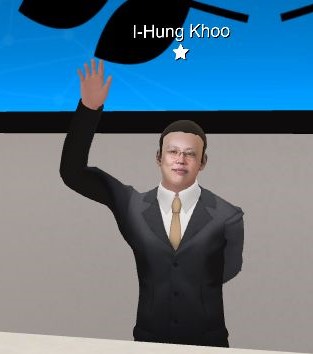A New Classroom Dimension

On September 17, 1994, the children’s TV program “Magic School Bus” aired an episode where students, using the titular vehicle, take a trip down someone’s digestive system. This semester—without any magic—CSULB Biomedical Engineering students created a virtual reality experience that allows the same lesson.
Launched this semester, the CSULB MetaCenter and the senior design courses it facilitates represent a new frontier for the College of Engineering.
“People are used to using it for gaming, and students are having fun while learning. It’s great to see their engagement,” said Emel Demircan, associate professor in both the biomedical and mechanical & aerospace engineering departments. “We are super excited because it's a first in the college of engineering. We see excitement from the students, and it's gotten better every week.”
Recent strides in virtual reality technology have given the tool a wider range of applications. From manufacturers training new operators virtually to doctors educating patients about surgeries, virtual reality represents a new frontier.
Demircan, along with her colleague I-Hung Khoo, professor of biomedical and electrical engineering, are training a generation of engineers that can both design and utilize VR.
“We need to not only use what is available but also develop our own libraries and assets. This requires a lot of programming, which we integrate into our curriculum,” said Demircan. “We want our students, especially our biomedical and mechanical engineering students, to get immersed in programming. They aren’t just going to use the system, they are going to develop new environments.”

Both Demircan and Khoo utilize VR in their research, recently receiving a patient for developing a system that integrates sensors, feedback and virtual reality.
“Originally, we plan to use this system for professional athletes, in order to improve performance and prevent injuries,” said Demircan. “The motivation is to eventually create a low-cost version that can be used outside the lab environment, in people’s homes, in hospitals or in the field.”
Khoo, for instance, is hard at work improving sensors that VR systems utilize.
“In terms of sensing [the system] is really just in the hands, not even the fingers. So our hope is that we can bring in additional sensors, ones that could detect fingers or maybe even full-body. That would create a lot of different ideas on how we could make VR more useful,” he explained.
These new strides could not only make a difference in life-saving surgeries or military training, but could improve the efficiency and functionality of something as mundane as a cross-country meeting.
“VR brings a new dimension [to meetings],” said Khoo. “On Zoom we just look at each other through a camera, but with VR you can actually interact, work on a product together, manipulate objects, write on whiteboards. It’s as if you are together in the same room.”
With the first semester in the MetaCenter complete, Demircan and Khoo are excited at what the future holds. Partnerships on faculty research, hosting outreach events, working on projects with industry leaders, the possibilities are virtually limitless.
For more information please contact: coe-metacenter@csulb.edu






